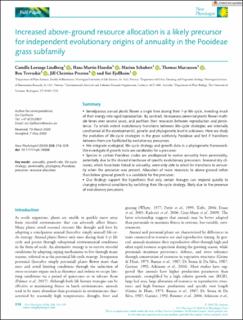| dc.contributor.author | Lindberg, Camilla Lorange | |
| dc.contributor.author | Hanslin, Hans Martin | |
| dc.contributor.author | Schubert, Marian | |
| dc.contributor.author | Marcussen, Thomas | |
| dc.contributor.author | Trevaskis, Ben | |
| dc.contributor.author | Preston, Jill Christine | |
| dc.contributor.author | Fjellheim, Siri | |
| dc.date.accessioned | 2021-02-10T15:15:36Z | |
| dc.date.available | 2021-02-10T15:15:36Z | |
| dc.date.created | 2021-01-27T10:09:57Z | |
| dc.date.issued | 2020-05-18 | |
| dc.identifier.citation | New Phytologist. 2020, 228 (1), 318-329. | en_US |
| dc.identifier.issn | 0028-646X | |
| dc.identifier.uri | https://hdl.handle.net/11250/2727271 | |
| dc.description.abstract | Semelparous annual plants flower a single time during their 1‐yr life cycle, investing much of their energy into rapid reproduction. By contrast, iteroparous perennial plants flower multiple times over several years, and partition their resources between reproduction and persistence. To which extent evolutionary transitions between life‐cycle strategies are internally constrained at the developmental, genetic and phylogenetic level is unknown. Here we study the evolution of life‐cycle strategies in the grass subfamily Pooideae and test if transitions between them are facilitated by evolutionary precursors. We integrate ecological, life‐cycle strategy and growth data in a phylogenetic framework. We investigate if growth traits are candidates for a precursor. Species in certain Pooideae clades are predisposed to evolve annuality from perenniality, potentially due to the shared inheritance of specific evolutionary precursors. Seasonal dry climates, which have been linked to annuality, were only able to select for transitions to annuality when the precursor was present. Allocation of more resources to above‐ground rather than below‐ground growth is a candidate for the precursor. Our findings support the hypothesis that only certain lineages can respond quickly to changing external conditions by switching their life‐cycle strategy, likely due to the presence of evolutionary precursors. | en_US |
| dc.language.iso | eng | en_US |
| dc.publisher | John Wiley & Sons Ltd. | en_US |
| dc.rights | Navngivelse 4.0 Internasjonal | * |
| dc.rights.uri | http://creativecommons.org/licenses/by/4.0/deed.no | * |
| dc.subject | Fylogeni | en_US |
| dc.subject | Phylogeny | en_US |
| dc.title | Increased above‐ground resource allocation is a likely precursor for independent evolutionary origins of annuality in the Pooideae grass subfamily | en_US |
| dc.type | Peer reviewed | en_US |
| dc.type | Journal article | en_US |
| dc.description.version | publishedVersion | en_US |
| dc.rights.holder | © 2020 The Authors | en_US |
| dc.subject.nsi | VDP::Zoologiske og botaniske fag: 480 | en_US |
| dc.subject.nsi | VDP::Zoology and botany: 480 | en_US |
| dc.source.pagenumber | 318-329 | en_US |
| dc.source.volume | 228 | en_US |
| dc.source.journal | New Phytologist | en_US |
| dc.source.issue | 1 | en_US |
| dc.identifier.doi | 10.1111/nph.16666 | |
| dc.identifier.cristin | 1880135 | |
| dc.relation.project | Norges forskningsråd: 231009 | en_US |
| cristin.ispublished | true | |
| cristin.fulltext | original | |
| cristin.qualitycode | 2 | |

